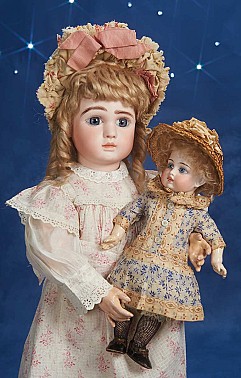Reform Character,Model 104,by Kammer and Reinhardt in Impeccable Original Condition
Lot #149
20" (51 cm.) Bisque socket head with very deeply-sculpted facial features depicting a gently-
smiling child,with defined eye sockets,painted blue eyes with darker blue iris rims,heavily-
modeled eyelids with thick black upper eyeliner,one stroke brows,accented nostrils,closed
mouth with well-defined and outlined lips,blonde mohair wig,composition and wooden ball-
jointed body. Condition: generally excellent. Marks: K*R 104. Comments: Kammer and
Reinhardt,from their art-reform character series,1910. Value Points: considered one of the
rarest antique dolls (only two or three others are known to exist),this particular example is
impeccable in its state of preservation,and exceptionally fine in its modeling,and quality of
bisque and painting,with original wig,body,wonderful body finish,and superb costume. It is a
most felicitous circumstance to find this art doll at all,and to find it in such impeccable
original condition is unparalleled. About the K*R art-reform character series. Long considered
keynote in the history of dolls,both for their rarity and their artistry,it was not until
1987,nearly 80 years after their creation,that the origin and complete story of these dolls
became known,thanks to the tireless research of German scholars,Marianne and Jurgen
Cieslik. The first clue appeared in memoirs of Franz Reinhardt who said that in their quest to
create this new type of realistic doll "we contacted a Berlin artist who had been recommended
to us". But no mention was made of the artists name. Then,years later,another clue surfaced,It
was an obscure reference in a German newspaper article of 1928 which dealt with the
Walterhausen doll industry,and said "the first dolls of this type were created based on the
head of a baby modeled from nature by Professor Lewin-Funcke". Based on this long-hidden
clue,the Ciesliks tracked down the family of Lewin-Funcke and uncovered still more important
information regarding which models he sculpted and who served as the model. They learned
that the model for the 104 was Karin Lewin-Funcke,the daughter of the sculptor. An old
handwritten note from K*R notes: 103: Girl "serious"/58 cm; 104: Girl "laughing"/no height
given; 105: Girl "friendly". 50 and 58 cm. As for the dolls themselves,they were,for the most
part,a commercial failure. Marianne Cieslik,currently at work on a new edition of German Doll
Encyclopedia,noted in an email "None of the three models of Karin [103,104,105] was a
success at that time and only some were used in the big shops in Berlin for decoration. In
articles in toy magazines you can read that hundreds of the heads were smashed because of
overstock. When you compare the many different heights of the big sellers _
100,101,109,112,and 114 _ [one realizes that] all other K*R characters were an experiment
only". About this doll. It is being sold from the original Bustios family estate. Early in the 20th
century,the noble Spanish family of Bustios emigrated from their family home to the mountain
town of Puno in Peru,bringing with them family treasures,furnishings,and everyday objects of
daily life including several trunks of dolls and toys for the children of the family; the trunks
were never opened,the dolls and toys remaining packed away,unplayed with and perfect
preserved. Among the many wonderful dolls was one particular treasure,this model 104 which
was stored entirely as found today,with original wig,body and exceptional original trachten-
ware costume of fine wools with rich embroidery.






























































































































































































































































































































































































































































































